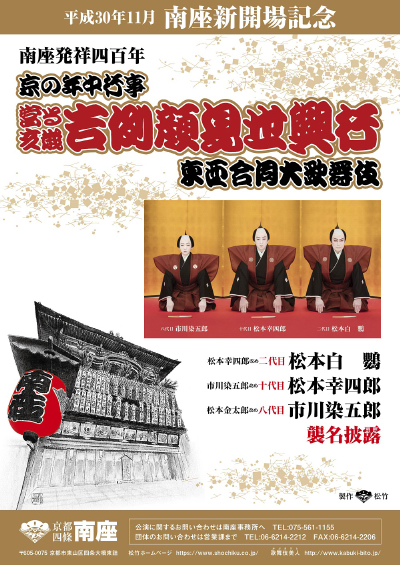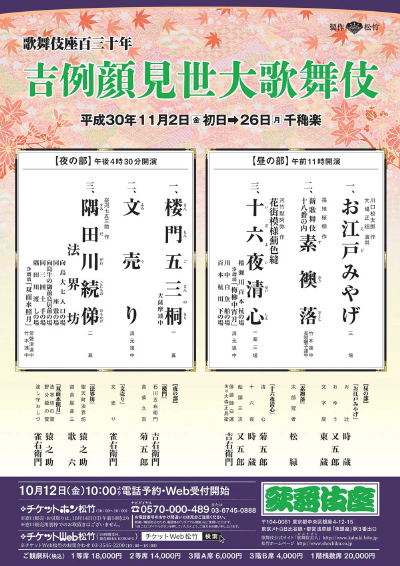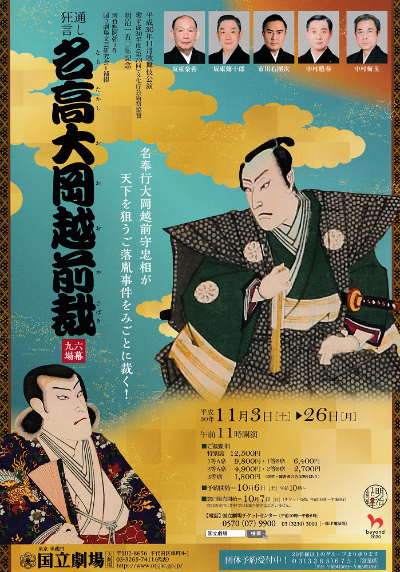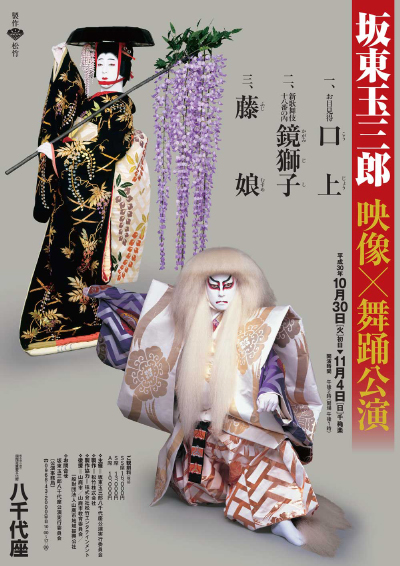| NOVEMBER 2018 |
|
|||
| Dates | 1 ~ 25 November 2015 Kichirei Kaomise K˘gy˘ Annual Festive Face-Showing Performances |
||
| MatinÚe | |||
| Evening | |||
| Casting |
Living National Treasure Kataoka Nizaemon, Living National Treasure Sakata T˘jűr˘, Matsumoto Haku˘, Matsumoto K˘shir˘, Ichikawa Somegor˘, Nakamura Ganjir˘, Kataoka Takatar˘, Kataoka Ainosuke, Kataoka Hidetar˘, Ichikawa Sadanji, Nakamura Kazutar˘, Band˘ Takesabur˘, Ichikawa Komaz˘, ďtani Tomoemon, Nakamura Kikaku, Kataoka Shinnosuke, Kataoka Ichiz˘, Kamimura Kichiya, Sawamura S˘nosuke, Matsumoto Kingo, ďtani Hirotar˘, Ichikawa Otora, Kataoka Matsunosuke, Nakamura Jűjir˘ |
||
| Comments |
The Minamiza reopens in a newly-refurbished structure! The opening program is a kaomise with Matsumoto Haku˘ II, his son Matsumoto K˘shir˘ X and his grandson Ichikawa Somegor˘ VIII celebrating their shűmei in this prestigious theater.
|
||
 |
 |
| Kabukiza (T˘ky˘) |  |
| Dates | 2 ~ 26 November 2018 Kichirei Kaomise ďkabuki Annual Festive Face-Showing Grand Kabuki |
| MatinÚe |
Sato Moy˘ Azami no Ironui (Izayoi Seishin) |
| Evening |
Fumi Uri |
| Casting |
Living National Treasure Onoe Kikugor˘, Living National Treasure Nakamura Kichiemon, Living National Treasure Nakamura T˘z˘, Nakamura Jakuemon, Nakamura Tokiz˘, Ichikawa Ennosuke, Onoe Sh˘roku, Nakamura Karoku, Nakamura Matagor˘, Ichikawa Danz˘, Ichikawa Monnosuke, Band˘ Kamez˘, Ichikawa Emisabur˘, Ichikawa Emiya, Ichikawa Juen, Band˘ Minosuke, Nakamura Baishi, Nakamura Kichinoj˘, Nakamura Kash˘, Nakamura Hayato, Nakamura Tanenosuke, Onoe Ukon |
| Comments |
The traditional November kaomise programs at the Kabukiza.
|
 |
| National Theatre (T˘ky˘) |
| Dates | 3 ~ 26 November 2018 |
| Program | |
| Casting |
Nakamura Baigyoku, Nakamura Kaishun, Band˘ Yajűr˘, Band˘ Rakuzen, Ichikawa Udanji, Band˘ Hikosabur˘, Ichikawa Sai'nyű, Ichimura Kakitsu, Band˘ Shűch˘, Ichikawa Omez˘, Nakamura Matsue, ďtani Keiz˘, Arashi Kitsusabur˘, Nakamura Kamenoj˘, Ichikawa Ukon |
| Comments |
Revival at the National Theatre of Kawatake Mokuami's drama "Ten'ichib˘":
|
 |
| Heisei Nakamuraza (T˘ky˘) | |
| Dates | 1 ~ 26 November 2018 |
| MatinÚe | |
| Evening |
Iya Sakae Shibai no Nigiwai Bukaku Goj˘bashi |
| Casting |
Nakamura Kankur˘, Nakamura Shichinosuke, Nakamura Shikan, Nakamura Senjaku, Kataoka Kamez˘, Nakamura Kotar˘, Band˘ Shingo, Nakamura Baika, Ichikawa Fukutar˘, Nakamura Toranosuke, Nakamura Tsurumatsu, Nakamura Kantar˘, Nakamura Ch˘zabur˘
|
| Comments |
The Heisei Nakamuraza is back in T˘ky˘ in Asakusa. These two programs commemorate the 6th anniversary (7th memorial services) of the passing away of the Heisei star Nakamura Kanzabur˘ XVIII. |
 |
|
|||
| Dates | 3 ~ 27 November 2018 Jűichigatsu Hanagata Kabuki November Young Actors Kabuki |
||
| Program |
Arashi no Yoru ni |
||
| Casting |
Nakamura Shid˘, Onoe Matsuya, Nakamura Kinnosuke, Ichimura Manjir˘, Kawarasaki Gonjűr˘, Nakamura Mantar˘, Nakamura Yonekichi, Ichimura Takematsu, Ichimura Kitsutar˘ |
||
| Comments |
The newly-created Kabuki drama "Arashi no Yoru ni", which was based on Kimura Yűichi's famous series of illustrated child books "Arashi no Yoru ni" (in English 'One Stormy Night') and which was premiered in September 2015 in Ky˘to at the Minamiza [more details], is staged for the first time in Fukuoka at the Hakataza with almost the same casting.
|
||
 |
|
|||
| Dates | 30 October ~ 04 November 2018 Band˘ Tamasabur˘ Eiz˘ x Buy˘ K˘en Band˘ Tamasabur˘ Image and Dance Performances |
||
| Program | |||
| Casting |
Living National Treasure Band˘ Tamasabur˘ |
||
| Comments |
A special Buy˘ program starring the amazing Living National Treasure onnagata Band˘ Tamasabur˘ in Yamaga at the Yachiyoza, a traditional wooden-built theater. There will be a mix of video projection (with video sequences coming from the high-quality Shinema Kabuki, "Cinema Kabuki") and real dancing on stage.
|
||
 |
| Classics Tour | |
| Dates | 5 ~ 30 November 2018 (Koten he no Izanai) Invitation to the Classics |
| Program |
Hibiki Goaisatsu |
| Casting |
Ichikawa Ebiz˘, Ichikawa Kudanji, ďtani Hiromatsu, Ichikawa Fukutar˘ |
| Comments |
The second leg (November) of the Fall Tour of Ichikawa Ebiz˘ with performances in 14 cities. The first number in the program is not a Kabuki dance-drama but a performance of taiko drum. The second item is a greetings stage talk ("Goaisatsu") done by Ichikawa Ebiz˘.
|
|
|
| Contact | Main | Top | Updates | Actors | Plays | Playwrights | Programs | Links | FAQ | Glossary | Chronology | Illustrations | Prints | Characters | Derivatives | Theaters | Coming soon | News |
